Picking the right pan isn’t just about the color or what fits in our cabinet. Ceramic and nonstick pans throw down in the kitchen arena, and it’s a hot topic for anyone who’s ever had to scrub a pan for hours. Been there, done that.
Think about it. Ceramic boasts eco-friendly creds, while nonstick shouts easy cleanup. We’ve all faced the midnight oil, wrestling with dishes that refuse to budge.
Here’s our two cents. It’s a showdown worth watching.

Understanding Ceramic Cookware
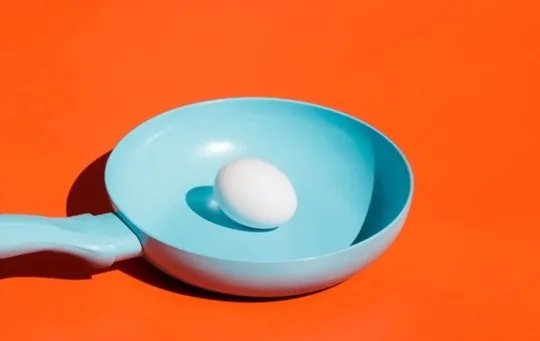
Ceramic cookware is made of clay that has been fired at high temperatures, resulting in a hard, smooth finish.
This coating is non-reactive, which means it will not interact with acidic food and alter its taste.
Furthermore, the surface of ceramic cookware does not contain harmful chemicals like PFOA, PFAS or cadmium that are common in nonstick pans.
Another benefit of ceramic cookware is that it distributes heat evenly and retains heat well due to its thermal qualities.
However, one drawback of ceramic cookware is that it can be easily scratched when exposed to metal utensils or abrasive cleaning products.
Also, some cheaper ceramic pans may contain lead or other hazardous materials so it’s crucial to buy from reputable brands.
To conclude, for those who value healthy cooking without compromising flavor and convenience, ceramic cookware would be an excellent choice.
Understanding Nonstick Cookware
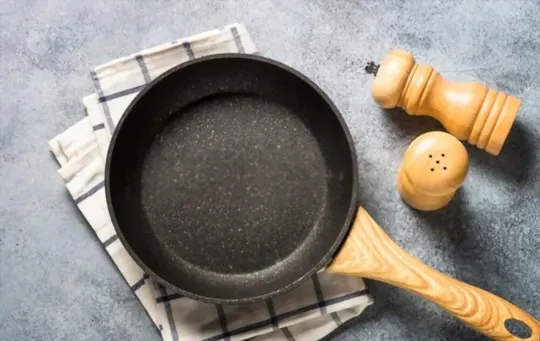
Cookware with a nonstick surface has become popular because of its convenience and ease of cleaning.
The nonstick coating prevents food from sticking to the pan, reducing the amount of oil needed for cooking.
This type of cookware is usually made from metal with a layer of nonstick material such as polytetrafluoroethylene (PTFE), ceramic or silicone.
Nonstick cookware is versatile and can be used for different cooking methods, such as frying, sautéing, and baking.
However, it is important to note that nonstick coatings can be sensitive to high heat and repeated scratches can cause the coating to peel off, exposing the metal underneath.
This may affect the taste and safety of your food.
It is advisable to use non-metallic utensils when cooking with nonstick cookware to avoid scratching.
In addition, some people have concerns about the potential health risks associated with PTFE-based nonstick coatings when heated above certain temperatures.
Therefore, ceramic-based nonstick cookware has become another popular option for those who prefer an alternative that is free from potentially harmful chemicals.
Overall, it really depends on personal usage preference between ceramic vs nonstick coated pans.
Both have their advantages depending on what you are looking for – easy cleaning or health concerns, etc.
, so consider your individual needs before making a decision.
Differences Between Ceramic and Nonstick Cookware
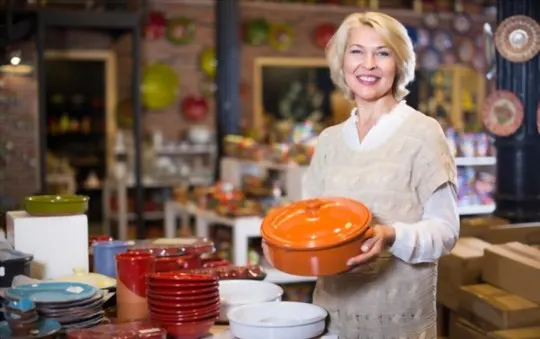
Ceramic and Nonstick cookware differ in terms of their cooking surface coating.
Ceramic cookware has an inorganic, ceramic-based coating, while nonstick cookware possesses a synthetic polymer-based coating.
Ceramic cookware offers even heat distribution, is scratch-resistant and environmentally friendly, while nonstick cookware prevents food from sticking to its surface and requires less oil for cooking.
However, some nonstick coatings contain harmful chemicals that may be released into the air during cooking.
It’s essential to consider the material composition before purchasing any type of cookware.
1 – Material Composition
The material composition of cooking utensils plays a crucial role in determining their usability and longevity.
The composition affects the cookware’s heating ability, durability, and ease of maintenance.
Ceramic cookware is made from natural clay that is heated to form a hardened surface while nonstick cookware features a coating based on polymers or PTFE.
Ceramic cookware has gained popularity due to its natural composition, easy cleaning and resistance to scratches and chips.
It is also free of chemicals like PFOA and PFTE commonly found in nonstick coatings but can crack at high temperatures.
Nonstick cookware offers excellent food release properties but cannot withstand high heat, leading to flaking or toxic gases production.
One important factor that should be considered when choosing between Ceramic and nonstick options is the nature of your cooking needs.
While many factors come into play, such as price, availability and design preference, the choice largely depends on what you want out of your kitchen experience.
2 – Cooking Performance
Cooking Efficiency – Both ceramic and nonstick pans have their own advantages when it comes to cooking efficiency.
Ceramic pans are great heat conductors, heating food evenly throughout the cooking process.
On the other hand, nonstick pans require less oil or butter due to their slick surfaces, preventing food from sticking and making cleaning easy.
However, ceramic pans take longer to heat up and may not be suitable for high-heat cooking methods like searing or broiling.
Durability – When it comes to durability, nonstick pans have a lifespan of a few years as their coating wears off over time.
In contrast, ceramic pans have a hard and scratch-resistant surface that can withstand high temperatures without chipping or flaking.
It is important to note that both types of pans require careful handling to maintain their longevity.
Versatility – Ceramic and nonstick pans are versatile in their own ways.
Nonstick pans are primarily designed for low-fat cooking, making them ideal for delicate foods like eggs and pancakes.
Whereas, ceramic pots can be used for sautéing vegetables, searing meats or frying because they can stand up well to higher temperatures.
3 – Durability and Longevity
When it comes to the longevity of your cookware, you want to choose a material that can stand the test of time.
Both ceramic and nonstick cookware have their own advantages and disadvantages in this regard.
Ceramic cookware is known for its durability and strength, as it can withstand high temperatures without warping or cracking.
Nonstick cookware, on the other hand, typically has a shorter lifespan as the coating tends to degrade over time with frequent use.
While both options may require replacement after extended usage, proper care and maintenance can extend their life span significantly.
Avoid using metallic utensils that may scratch the non-stick surface of your pots and pans.
Similarly, excessive heat exposure may cause damage to ceramic coating; therefore, avoid continuous usage on high flame.
Ultimately, a well-made ceramic pot or pan or a nonstick option from a reputable brand should last you several years if used correctly with proper care and handling.
4 – Versatility and Heat Resistance
The range of temperatures at which ceramic and nonstick pans can be used is an important factor to consider in determining their versatility and heat resistance.
Ceramic cookware is known for being able to withstand higher temperatures than nonstick pans, making them a better option for searing or cooking at high heat.
On the other hand, nonstick coatings are not as durable under high heat and may begin to deteriorate over time.
Additionally, nonstick coatings should not be exposed to extremely high heats in order to avoid the release of harmful chemicals.
It is important to choose the right type of cookware based on your intended use and the types of meals you typically prepare.
Similarities Between Ceramic and Nonstick Cookware
Ceramic and Nonstick cookware share quite a few similarities, making them popular amongst home cooks and professional chefs.
- Both types of cookware are designed to prevent food from sticking to the surface while cooking, allowing for easier clean-up.
- They are both made with non-reactive materials that do not alter the taste or color of food.
Last but not the least, both types of cookware work well with low heat cooking methods such as simmering and sautéing.
When it comes to durability, ceramic and nonstick cookware have their differences.
While nonstick coatings tend to wear out over time due to frequent use and exposure to high heat, ceramic coatings have a longer lifespan.
Both types of cookware need to be handled with care as harsh scrubbing can damage the surface.
In terms of versatility, nonstick cookware is suitable for cooking delicate foods like eggs and fish without them falling apart.
On the other hand, ceramic cookware can withstand high oven temperatures making them ideal for baking dishes like lasagnas or casseroles.
All in all, whether you choose ceramic or nonstick cookware depends on your personal preference and cooking needs.
Both options have their benefits and drawbacks but can make cooking enjoyable and hassle-free.
Considerations for Choosing Between Ceramic and Nonstick Cookware
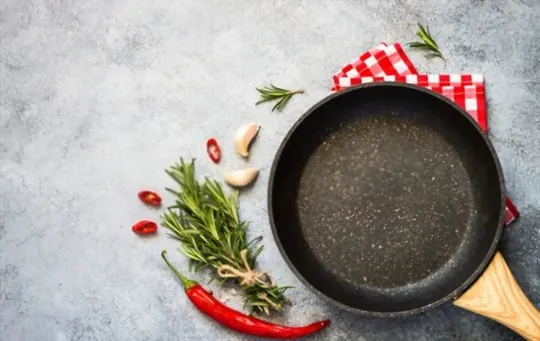
When browsing for cookware, one may be conflicted between ceramic and nonstick options.
Both have their unique attributes that make them stand out in their own ways.
For instance, ceramic cookware is chemical-free and has a high heat tolerance, making it an excellent option for searing meat.
On the other hand, nonstick pans are renowned for their convenience, being easy to clean and requiring minimal oil or butter while cooking.
However, you should consider factors such as durability, scratch resistance, cost, and your cooking style when deciding which type of cookware to purchase.
1 – Cooking Style and Preferences
For those who seek a cooking experience tailored to their preferences, understanding how ceramic and nonstick cookware affect the way food is prepared can make a big difference.
Ceramic pots and pans are known for holding heat well and creating a perfectly browned crust without burning, whereas nonstick varieties are popular for their lower-fat cooking capabilities.
Whether one prefers searing meats or flipping eggs with ease, choosing between these materials can help enhance the overall cooking experience.
Furthermore, depending on what type of cuisine one enjoys making, there may be specific considerations to keep in mind when deciding which type of cookware to purchase.
For example, dishes that require high-heat or long braising times might do better with ceramic cookware while more delicate fare like fish or omelets could benefit from the slick surface of nonstick pans.
Additionally, those looking for a multifunctional option might consider purchasing both types of cookware for versatility in the kitchen.
In contrast to traditional aluminum or stainless steel pots and pans, ceramic and nonstick options offer unique benefits that can affect the final outcome of nearly any meal.
By taking into account individual culinary preferences and examining each material’s attributes closely, home cooks can make informed decisions on which type of cookware will best suit their needs without sacrificing flavor or quality.
2 – Maintenance and Care
Maintaining and caring for your cookware is crucial in ensuring its longevity and preserving the quality of your food.
Here are some tips on how to take care of your pots and pans.
- Cleaning: Always read the manufacturer’s instructions before cleaning your cookware. Most ceramic and nonstick pans are dishwasher safe, but it’s always best to hand wash them with mild soap and water. Avoid using abrasive cleaners or scouring pads as they may scratch the surface.
- Storing: Store cookware in a dry place to avoid moisture build-up that can cause rust or mold formation. Use protective liners such as paper towels or felt to prevent scratches during storage.
- Seasoning: Some nonstick pans benefit from seasoning, which helps maintain their nonstick properties. Follow the manufacturer’s instructions on how to season your pan.
- Handling: Handle cookware with care, avoiding sharp objects that can scratch the surface. Never use metal utensils on nonstick surfaces, as this can damage the coating.
It’s important to note that some types of cookware require special care, such as cast iron or copper.
Always refer to the manufacturer’s instructions for specific guidelines.
Proper maintenance and care not only prolongs the lifespan of your cookware but also ensures the safety and quality of your cooking.
3 – Safety Considerations
When weighing between Ceramic and Nonstick, Safety is a key consideration.
Understanding the impact of using each kind, will determine which one to choose.
In terms of safety, Ceramic is generally more favored than Nonstick due to its chemical-free nature.
Despite their eco-friendly appeal, limited safety concerns do exist with ceramic cookware such as cracking or chipping that could cause lead poisoning, exposure to cadmium leaching into food or heat-related mishaps.
Therefore it’s also important to educate oneself on how to properly clean and handle ceramic pans for safe use.
While Ceramic overwhelmingly has benefits in terms of health and safety compared to Nonstick pans, it’s essential you read the instructions and understand how each individual type works.
Like all materials they have their limitations and considerations too.
Popular Brands and Options in Ceramic and Nonstick Cookware
When it comes to cookware, choosing between ceramic and nonstick options can be daunting.
Both have their own benefits and drawbacks.
Ceramic cookware is made from clay and other natural minerals, making it safe and eco-friendly.
On the other hand, nonstick cookware is designed with a special coating that prevents food from sticking to it.
Popular brands in ceramic include Caraway, GreenLife, and Xtrema.
In nonstick cookware, T-fal, All-Clad, and Calphalon are some of the popular options.
Consider your cooking needs before making a decision.
In terms of durability, ceramic cookware can easily chip or crack if dropped while nonstick options can wear out over time due to all the cooking happening on its surface.
Ceramic can also distribute heat more evenly than nonstick but requires some sort of oil or butter for cooking.
Nonstick pans come coated with a layer of PTFE or Teflon which is known to release harmful chemicals in high temperatures.
If you’re looking for an option that’s easy-to-clean, both ceramic and nonstick make an excellent choice as they don’t require too much elbow grease to wash up after use.
Furthermore, both types come in various sizes ranging from single-serve pots to larger Dutch ovens which makes them versatile for different dishes.
As you weigh your options when selecting between ceramic and nonstick cookware, consider your budget as well as heating preferences too.
Remember that choosing good quality materials will guarantee an enjoyable cooking experience.
Conclusion
When deciding between ceramic and nonstick cookware, there are several factors to consider.
In terms of durability and versatility, ceramic cookware tends to come out on top, while nonstick cookware excels in convenience and ease of use.
Ultimately, the best option depends on personal preference and cooking needs.
Additionally, it’s important to consider the potential health effects of each type of cookware.
Some nonstick coatings contain potentially harmful chemicals that could be released when exposed to high heat, while ceramic coatings tend to be free from such concerns.
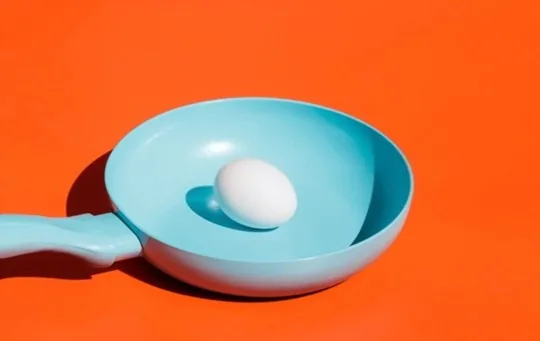
Ceramic vs Nonstick: Which is a Better Option?
Ingredients
- Ceramic
- Nonstick
Instructions
- Choose between ceramic and nonstick cookware based on your preference and cooking needs.
- Follow the cooking instructions for your chosen cookware, adjusting heat and cooking times accordingly.
- Prepare your ingredients as directed in your recipe, ensuring they are properly measured and ready for cooking.
- Heat the ceramic or nonstick pan on the stove to the desired temperature.
- Add the ingredients to the pan, using the appropriate cooking oil or nonstick spray if required.
- Cook the ingredients according to your recipe, stirring or flipping as needed.Monitor the cooking process to prevent sticking or burning, adjusting heat as necessary.
- Once the food is cooked to your satisfaction, remove it from the pan.
- Clean your ceramic or nonstick cookware according to the manufacturer's instructions.
- Enjoy your delicious creation, appreciating the unique qualities and benefits of either ceramic or nonstick cookware.
- Explore different recipes and techniques to fully utilize the capabilities of your chosen cookware option.

Andrew Gray is a seasoned food writer and blogger with a wealth of experience in the restaurant and catering industries. With a passion for all things delicious, Andrew has honed his culinary expertise through his work as a personal chef and caterer.
His love for food led him to venture into food writing, where he has contributed to various online publications, sharing his knowledge and insights on the culinary world. As the proud owner of AmericasRestaurant.com, Andrew covers a wide range of topics, including recipes, restaurant reviews, product recommendations, and culinary tips.
Through his website, he aims to inspire and educate fellow food enthusiasts, offering a comprehensive resource for all things food-related.

Leave a comment